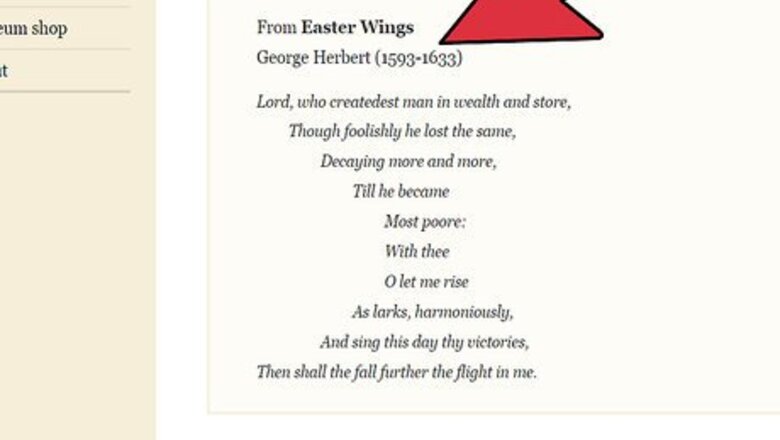
views
Brainstorming Ideas
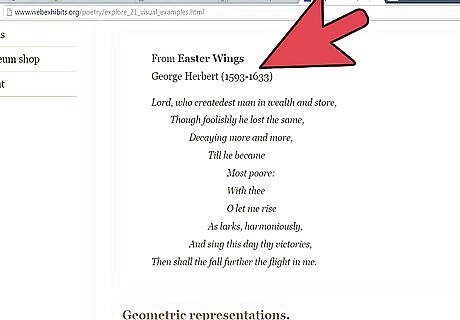
Read examples of shape poems. To get a better sense of what you can do in a shape poem, you may want to read several examples of the form, such as: “O sweet spontaneous earth” by e.e. cummings. “Vision and Prayer” by Dylan Thomas. “Concrete Cat” by Dorthi Charles. “Butterfly” by David Schondelmeyer.
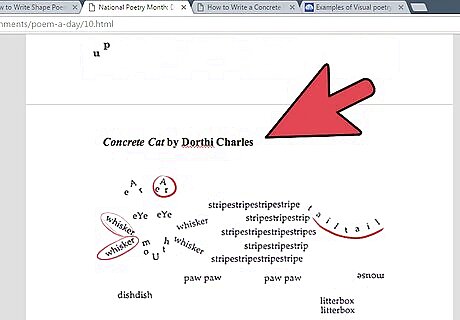
Analyze the examples. Review the examples and think about how the author uses the form of the shape poem. Consider several questions, including: How does the author use the shape of the poem to heighten the meaning of the poem? How does the text and the shape interact in the poem? For example, Charles’ “Concrete Cat” uses the text to form the shape of a cat, with each word forming it’s shape on the cat’s body. “Whisker” forms a whisker on the cat, “eye” forms an eye. This creates an interesting visual representation for the reader. How do the line breaks in the poem, created by the shape, add meaning and detail? For example, in Schondelmeyer’s “Butterfly”, the shape of the butterfly limits the number of words Schondelmeyer can use in the poem. But the shape also allows Schondelmeyer to create mirroring text and text that connects the two sides, or “wings” of the poem.
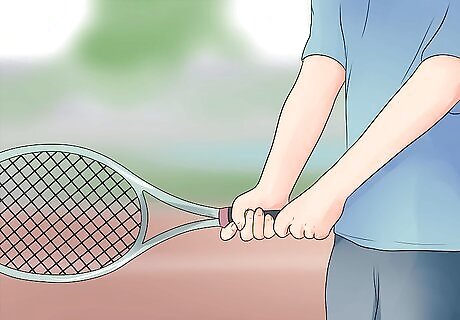
Focus on an activity or hobby you enjoy. To get inspiration for your shape poem, you may choose to focus on an activity you enjoy, like playing tennis or reading books. Or you may focus on a hobby, like woodworking or singing. You could then use this subject as the inspiration for your poem.

Get inspired by nature. Another area of inspiration could be the natural world. You may have a favorite tree in your backyard or a flower bush you like in your neighborhood park. You may be inspired by nature on a larger scale, such as a famous waterfall in your area or a river that runs through your city. Get specific and choose one aspect of nature or the natural world as the subject of your poem. You may also be inspired by a particular animal in the natural world, such as the fierceness of a lion or the grace of a gazelle. You may then pick an animal and use it as inspiration for your poem.

Pick your favorite object or an object of sentimental value. You may decide to jump right away to an object that you value for sentimental reasons and use it as inspiration for your poem. Maybe you have a family heirloom that has been passed down to you from your mother or a lucky pen that you refuse to throw away. You could then write a poem in the shape of the object that focuses on why you love the object so much or why you value it.
Creating the Shape
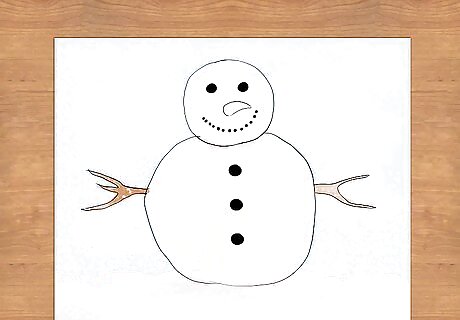
Select a shape that represents the subject of your poem. Once you have selected the subject of your poem, you should think about what shape best represents the subject. You may choose a more obvious shape to represent your subject, such as a tennis racket to represent a poem about tennis. Or, you may choose a more obscure shape, such the shape of your grandmother’s watch to represent a poem about your grandmother. Keep in mind you will need to fit the text of the poem in the shape. So, you may want to select a shape that is wide or has a wide center. If you select a shape that is more challenging, such as the shape of a hand or the shape of a long, thin pen, you may need to be more creative with how you fit the text within the shape.

Make the shape template on a computer. One option for creating the shape template is to design it on your computer. You may use a drawing program to create the shape, making it big enough for you then type text in the shape. Alternatively, you can download shape templates online. You may use an existing template if you are using a common shape, such as the shape of a heart or the shape of a butterfly.
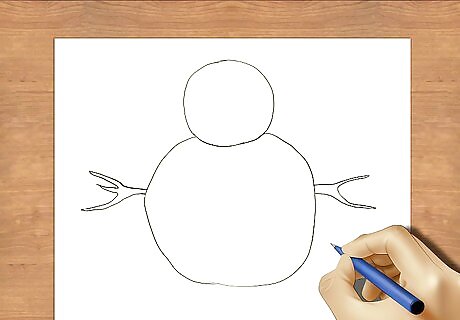
Draw the shape template on a piece of paper. If you would like to get more hands on, you can draw the shape on a piece of paper using your drawing skills and your imagination. You may use a stencil of the shape, depending on what it is, to ensure it is symmetrical and even. Make sure you draw the shape template so it is big enough to fit text.
Writing the Poem

Make a list of keywords and terms about the subject. To get your creative juices flowing, sit down and write as many keywords and terms you can think of about the subject. Try to be specific as you make this list, as you can then use it to pull words for your poem later. For example, if you are writing about tennis, you may write down “strings”, “grass”, “sweat”, “armbands”, “two handed forearm”, “tingling hands”. If you were writing about an object of sentimental value, like your grandmother’s watch, you may write down terms that relate to both your grandmother and the watch. For example, “ancient”, “ticking”, “light colored”, “delicate”, “wise”.

Focus on the five senses. Use sensory detail to really make your poem come alive. Consider how the subject of your poem might, smell, sound, look, taste, and feel. Include sensory details whenever possible to make your poem feel more descriptive. For example, maybe in your poem about tennis, you write about the smell of the grass courts, the sound of the ball hitting your racket, or the taste of sweat on your lips as you play a match. You may focus more on short descriptions of these sensory details, as your shape may only allow you to include a few lines of text.
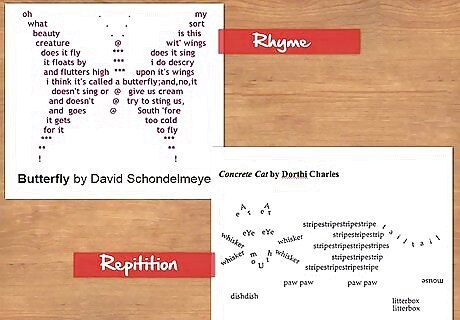
Use literary devices. Many shape poems use literary devices like rhyme, repetition, and metaphor. These devices can be a good way to inject energy and engagement into your poem. Rhyme: This is a pattern of words that produce the same sound or similar sounds. Rhyme is often used in shape poems as a way to tie the lines together, especially if your shape creates breaks or gaps between the lines of text. For example, in Schondelmeyer’s “Butterfly”, the author has rhyming lines: “Oh what a beautiful creature, does it fly/ it floats by/and flutters high/I think it’s called a butterfly…” Repetition: This is a pattern of the same words that repeat in sequence. Many shape poems use the repetition of words to create the shape of the poem or to reinforce the shape. For example, Charles’ “Concrete Cat” repeats the word “stripe” to create the striped lines on the cat’s body and repeats the word “whiskers” to create the whiskers of the cat. Metaphor: Metaphors are used often in poetry. In metaphor, a meaning or identity is given to the subject by way of another subject. For example, if you are writing about tennis, you may use the metaphor: “The racket is my sword in battle, the court is my green battlefield.”
Placing the Text
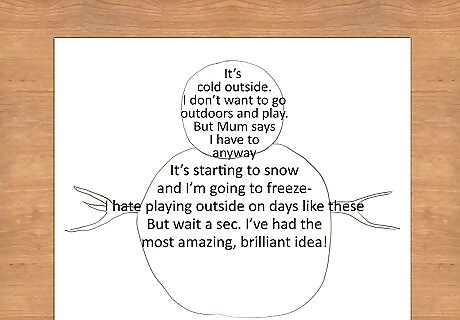
Arrange the text within the shape. Once you have created your poem, you are ready to place it in the shape. You may do this by writing the text directly into the shape, making sure the text stays within the lines of the shape. Or, you may cut out the words on the paper and arrange them so they form the shape of the text. Have fun with this part, as it is a critical step in making a shape poem. Focus on arranging the text so it forces the reader to look at the words within the shape or in a different way. For example, if you are writing about tennis and placing the text within the shape of a tennis racket, you may include details about the racket strings in the string section of the racket and details about swinging the racket in the handle section of the racket.
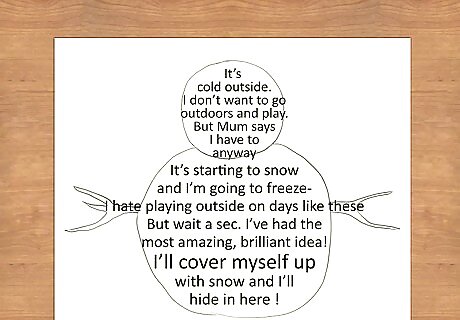
Edit the text in the shape. With your text in place, step back from the poem and read it within the shape. Note if there are any words that do not quite fit within the shape. Edit them so they are shorter and more concise, or remove them. Check if there are ways you can make the text more engaging by placing it in a different section of the shape. Most shape poems use the shape to play with the meaning of the text. You may also decide to edit down certain lines so they create the shape of the subject or object more clearly. Similar to Charles’ “Concrete Cat”, think about how your poem can represent the shape in very few words. This may be a fun challenge if you are looking for a different approach to your shape poem.
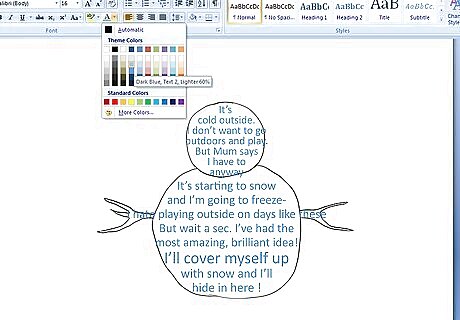
Add color to the shape poem. This is optional, but many shape poems have color. You may color the shape of the apple red if you are using an apple shape for your poem or you may color the handle of the tennis racket brown if you are using a tennis racket shape. Use colored pencils and/or markers to color in your shape. Be sure to use a lighter color so it does not obscure the text in the shape. You may want to go over the text with black pen or marker to ensure it stands out in the colored shape.



















Comments
0 comment